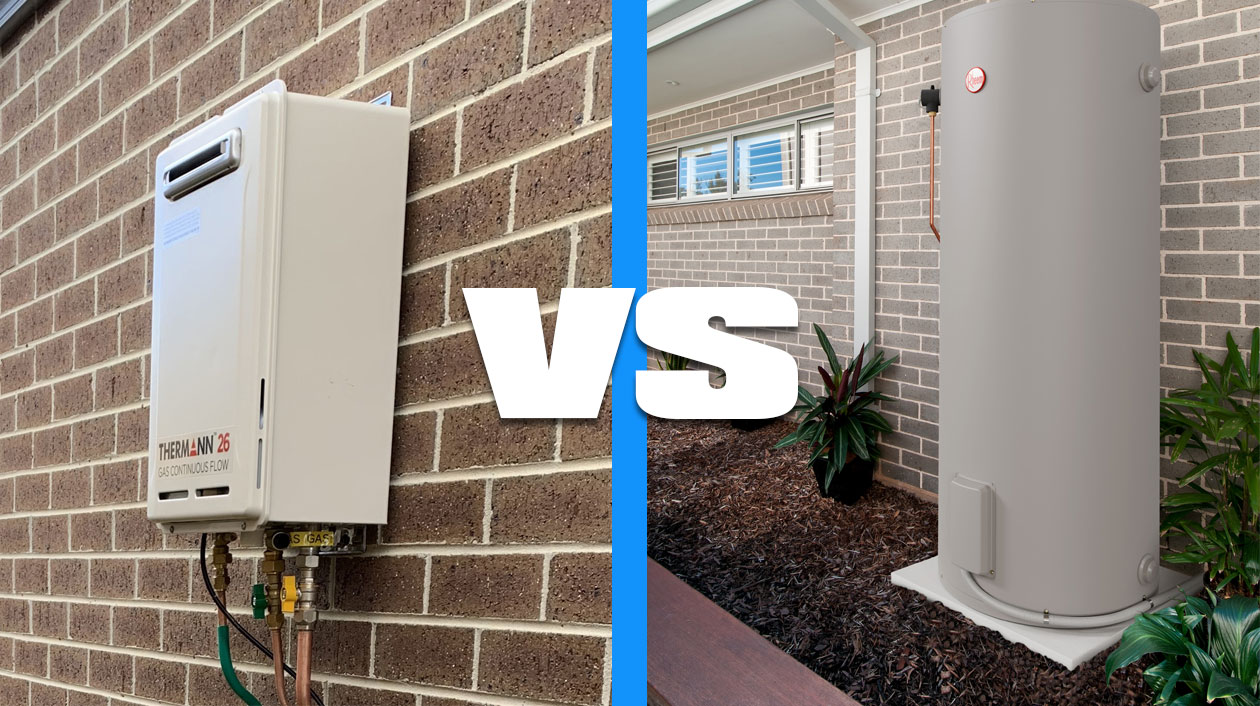Choosing a new hot water system can feel overwhelming. This guide compares gas and electric hot water systems. We’ll explore key factors like cost, efficiency, and environmental impact, which will help you make the best decision for your home.
| Feature | Gas | Electric |
|---|---|---|
| Fuel Type | Natural Gas/LPG | Electricity |
| Initial Cost | Higher | Lower |
| Operating Cost | Generally lower | Generally higher |
| Efficiency | Moderate to High | Moderate to Very High (Heat Pump) |
| Lifespan | 10-13 years | 8-12 years |
| Environmental Impact | Higher carbon emissions | Lower (especially with renewables) |
| Recovery Rate | Faster | Slower |
| Space Requirements | Requires venting | More compact (especially tankless) |
Initial Costs
When comparing gas and electric water heaters in Australia, there are some key differences in initial costs to consider:
Electric Water Heaters
Electric water heaters generally have the lowest upfront costs:
- Initial purchase price typically ranges from $300 to $1,500
- Installation costs are usually $250-$700
- Total initial cost (unit + installation) averages $1,000 to $2,000
Gas Water Heaters
Gas water heaters have a higher initial cost than electric but lower operating costs:
- Purchase price typically ranges from $900 to $2,000
- Installation costs are usually $280-$800
- Total initial cost (unit + installation) averages $1,500 to $3,000
Gas systems come in two main types:
- Storage tank: $900-$2,000 purchase price
- Instantaneous: $600-$2,000 purchase price
Operating Costs
Gas systems typically depend on the local availability and pricing of natural gas or propane, while electric water heaters hinge on the kilowatt-hour rates set by electric utilities. This variation in energy source pricing directly impacts the operating costs associated with each system type.
Electric Hot Water Heaters
Electric water heaters generally have higher operating costs compared to gas:
- Annual running costs range from $700 to $925 for standard electric storage systems
- On a continuous tariff, costs can be around $970 per year or $9,700 over 10 years
- Off-peak electric systems are cheaper at about $460 per year or $4,600 over 10 years
Gas Hot Water Heaters
Gas systems typically have lower operating costs than standard electric heaters:
- Annual running costs range from $295 to $665 for gas systems
- Gas storage systems cost about $570 per year to run
- Gas instantaneous systems cost around $540 per year when used with other gas appliances
However, if a gas hot water system is the only gas appliance, costs can increase to about $800 per year due to daily supply charges.
Comparison
For a typical 3-person household:
- 5-star gas storage system: $395 per year
- Electric storage system: $1,442 per year
- Gas instantaneous system: $803 per year
Energy Efficiency
Hot water system efficiency measures how well it converts fuel into usable hot water. Higher efficiency means less wasted energy, lower running costs, and reduced environmental impact.
Gas systems can be less efficient than electric heat pumps, though high-efficiency (condensing) gas models perform much better by reusing heat. Heat pumps are generally most efficient, extracting heat from the air. Star ratings indicate efficiency (more stars = higher efficiency). Heat pumps usually have the most stars, followed by condensing gas models, then standard electric.
Thermal efficiency measures heat transfer to water. Gas systems often lose heat through venting, while electric, especially heat pumps, minimise this loss. Understanding both overall and thermal efficiency helps assess system performance and potential savings.
Environmental Impact
Gas hot water systems directly emit greenhouse gases, including carbon dioxide and methane, during natural gas or propane combustion. These emissions contribute to climate change. The amount of greenhouse gases emitted depends on the system’s efficiency and the type of gas used.
Electric hot water systems don’t directly produce greenhouse gas emissions at the point of use. However, the electricity used to power them may be generated from sources that emit greenhouse gases, such as coal-fired power plants. The overall environmental impact of an electric system depends on the source of the electricity.
The increasing reliance on renewable energy sources, such as solar and wind power, is significantly changing the environmental landscape of electricity generation. As the electricity grid transitions towards cleaner energy sources, the environmental impact of electric hot water systems decreases correspondingly. If your electricity comes primarily from renewable sources, an electric hot water system, especially a heat pump, becomes more environmentally friendly.
Installation Requirements
Gas Hot Water System Installation
Gas hot water systems require a connection to a gas line. If your home doesn’t already have a gas supply, installing one can be a significant undertaking, involving excavation and connection to the main gas network. Adequate ventilation is crucial for gas systems to exhaust combustion byproducts safely. This often necessitates installing a flue or vent pipe, which can impact placement options. Specific gas safety regulations must be followed during installation, requiring a qualified and licensed gas fitter.
Electric Hot Water System Installation
Electric hot water systems generally have more straightforward installation requirements and can be done fairly quickly by a licensed hot water plumber. They primarily need a connection to the electrical supply with adequate amperage. While the electrical connections are relatively straightforward, upgrading your electrical panel might be necessary if it cannot handle the increased load of a new hot water system, especially for high-power models like heat pumps. Tankless electric systems, while compact, often require higher amperage than storage tank models, potentially necessitating electrical upgrades.
Maintenance and Lifespan
Gas hot water systems require periodic checks for gas leaks and proper ventilation. Annual servicing by a qualified gas fitter is recommended to ensure safe operation and identify potential issues. Components like the burner assembly and thermocouple may require occasional replacement. Electric hot water systems typically require less frequent maintenance. However, checking the anode rod periodically and flushing the tank annually helps prevent sediment buildup and corrosion, extending the tank’s lifespan. Elements in electric storage tank systems may eventually burn out and require replacement.
Regular servicing for gas systems involves inspecting the gas lines, burner, flue, and other components. For electric systems, flushing the tank removes sediment and maintains water quality. Replacing the anode rod in electric storage tank systems protects the tank from corrosion. The frequency of parts replacement depends on usage, water quality, and the specific system model.
Gas hot water systems typically last 10-13 years with proper maintenance. Electric hot water systems have a slightly shorter lifespan, averaging 8-12 years. Factors like water quality and usage patterns can influence the actual lifespan of both systems. Hard water can accelerate corrosion in gas and electric systems, potentially shortening their lifespan. Regular maintenance and proper water treatment can help mitigate these effects and maximise the lifespan of your hot water system.
Heating Speed and Recovery Rate
Heating speed refers to how quickly a hot water system can heat water initially, while recovery rate measures how quickly it can replenish hot water after usage.
Gas hot water systems generally boast faster heating speeds and recovery rates compared to standard electric storage tank models. The direct heat from burning gas allows for rapid heating of the water within the tank. This makes gas systems well-suited for households with high and frequent hot water needs.
Standard electric storage tank water heaters typically have slower heating and recovery rates than gas systems. The heating element takes time to raise the water temperature. Once hot water is used, the recovery process is relatively slow. However, electric tankless systems offer on-demand hot water, eliminating the concept of recovery rate. They heat water instantaneously as it flows through the unit, providing a continuous hot water supply. While electric heat pump systems have slower heating speeds than gas or standard electric, their superior insulation minimises heat loss, resulting in a more consistent water temperature and reducing the frequency of reheating.
Temperature Consistency
Gas hot water systems generally provide good temperature consistency, especially those with advanced temperature control features. However, fluctuations can occur, particularly during periods of high demand, where the incoming cold water mixes with the hot water in the tank, potentially leading to a temporary drop in temperature.
Standard electric storage tank water heaters sometimes struggle to maintain consistent temperatures, especially during heavy usage. As hot water is drawn from the tank, it’s replaced with cold water, leading to temperature fluctuations until the heating element reheats the water. Electric tankless systems excel at providing consistent hot water temperatures. They heat water on demand, eliminating the temperature fluctuations associated with storage tanks. Electric heat pump water heaters also offer excellent temperature consistency due to their superior insulation and precise temperature control mechanisms. They maintain a stable water temperature within the tank, minimising temperature drops even during periods of high demand.
Rebates and Incentives
Here’s a summary of gas and electric hot water rebates and incentives available in Australia:
Federal Rebates
Small-scale Technology Certificates (STCs) are available nationwide for installing renewable energy systems, including:
- Solar hot water systems
- Heat pump hot water systems
The number of STCs varies by location (climate zone) and system size. As of January 2024, STC values for heat pumps range from 16-22 certificates depending on the model and zone.
State-Specific Rebates
Victoria
- Victorian Energy Efficiency Certificates (VEECs):
- Worth $1,540 to $1,680 for heat pump systems
- Available when upgrading from inefficient electric or gas systems
- Solar Hot Water Rebate:
- Up to $1,000 for eligible households installing solar hot water systems
- Victorian Energy Upgrades program discounts:
- Heat pump replacing inefficient electric system: $840
- Solar-boosted system replacing inefficient electric: $1,190
- Heat pump replacing inefficient gas system: $490
- Solar-boosted system replacing inefficient gas: $700
Western Australia
WA offers several rebates:
- Up to $1,000 for solar hot water systems
- $300 for high-efficiency gas or electric-boosted solar systems
- $400 for switching from electric storage to continuous-flow gas
- Up to $1,000 for switching to heat pump systems
Queensland
- Climate Smart Energy Savers Rebate: $800 standard rebate or $1,000 low-income rebate for heat pump systems
- Business Energy Saving and Transformation (QBEST) Rebates: Up to $12,500 for eligible businesses installing energy-efficient equipment, including heat pumps
South Australia
- City of Adelaide offers up to $1,000 for solar hot water systems
New South Wales
- Energy Savings Certificates (ESCs) are available when replacing existing electric or gas systems with heat pumps



